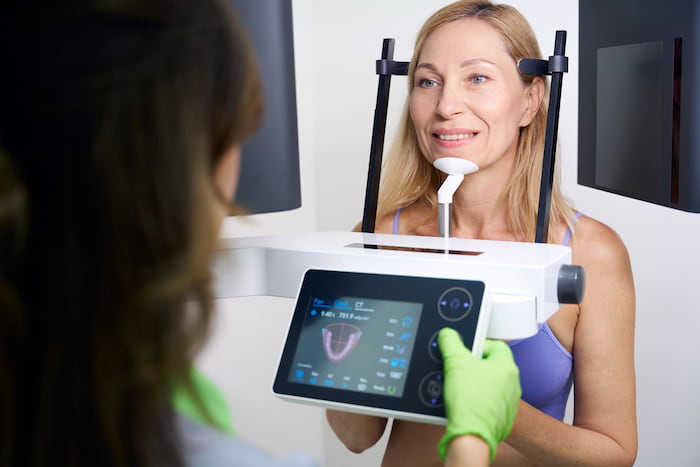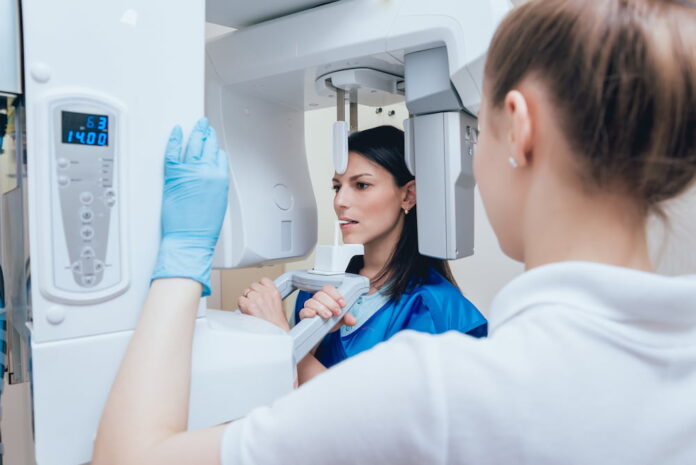In dentistry, the role of imaging technologies cannot be overstated. As a cornerstone of dental diagnostics and treatment planning, imaging techniques have evolved significantly over the years, revolutionizing how dental professionals visualize, diagnose, and treat various oral health issues.
That said, this article aims to provide a comprehensive overview of the current state of dental imaging technology, highlighting its benefits and offering insights into the future possibilities that these technologies may bring.
Cutting-Edge Advances In Dental Imaging
Dental imaging is undergoing a transformative evolution, marked by the emergence of cutting-edge technologies that promise to redefine the standards of dental diagnostics and treatment planning. As such, here are the most notable innovations currently shaping the future of dental imaging.
1- Cone Beam Computed Tomography (CBCT)
A dental cone beam computed tomography stands out as a pivotal advancement in dental imaging, offering three-dimensional views of the dental structures, soft tissues, nerve paths, and bones in the craniofacial region.
Unlike traditional CT scans that produce two-dimensional images, CBCT captures a cone-shaped beam of radiation that is processed to generate 3D images. This capability provides dentists with comprehensive insights into the patient’s oral anatomy, enabling precise planning and execution of treatments such as dental implants, orthodontic assessments, and complex surgeries.
2- Intraoral Cameras
Intraoral cameras have revolutionized patient consultations and diagnostic procedures in dentistry. These small, handheld devices are equipped with high-resolution cameras and LED lighting to illuminate the oral cavity, capturing detailed images and videos of the teeth and gums.
The technology behind intraoral cameras allows for a level of detail that surpasses traditional visual and manual examination methods. As a result, dentists can detect early signs of decay, gum disease, and other oral health issues more effectively.
3- Digital Volume Tomography (DVT)
DVT further refines the capabilities of dental imaging by providing exceptionally high-resolution three-dimensional images. This technology is beneficial for detailed analysis of the oral and maxillofacial regions, allowing dentists to assess the intricate anatomies of dental structures with unparalleled clarity. Moreover, DVT distinguishes itself from CBCT through its enhanced resolution, which is advantageous in identifying minute details critical for the successful planning and execution of dental procedures.
Benefits Of Advanced Dental Imaging Technologies
Advanced dental imaging technologies have brought about numerous benefits that significantly elevate the quality of dental care, enrich patient experiences, and improve treatment results, as follows:
Enhanced Diagnostic Precision
One of the most significant advantages of advanced dental imaging is the remarkable improvement in diagnostic accuracy. Technologies such as CBCT, DVT, and intraoral cameras provide detailed, high-resolution images that offer a comprehensive view of the oral and maxillofacial region. By identifying issues at an earlier stage, these technologies facilitate timely intervention, preventing the progression of dental problems and preserving the patient’s oral health.
Improved Treatment Planning And Execution
Advanced imaging technologies have revolutionized treatment planning by providing clear, three-dimensional views of the patient’s dental anatomy. This allows for more precise measurements, better visualization of treatment areas, and the ability to simulate surgical outcomes before actual procedures.
Minimized Invasiveness And Enhanced Patient Comfort
With the advent of these technologies, many diagnostic and treatment procedures have become less invasive. For example, digital impressions using intraoral scanners eliminate the need for traditional impression materials, which can be uncomfortable and trigger gag reflexes in some patients. Additionally, the ability to accurately plan treatments reduces the need for exploratory procedures, minimizing discomfort and recovery time for patients.
Increased Patient Engagement And Education
Advanced dental imaging technologies play a crucial role in patient education and engagement. Intraoral cameras and 3D imaging allow patients to see what the dentist sees, making it easier to understand their oral health conditions and the necessity of proposed treatments. This visual communication enhances patient trust and confidence in their dental care provider, leading to higher treatment acceptance rates and better compliance with recommended care plans.
Predictive Analysis And Preventive Care
Emerging technologies like AI in dental imaging are set to transform preventive care by enabling predictive analysis. AI algorithms can analyze dental images to identify early signs of issues such as decay, gum disease, or even the potential for orthodontic problems before they become visible to the naked eye. This predictive capability allows dentists to implement preventive measures early on, potentially avoiding more complex and costly treatments in the future.
..

Emerging Technologies In Dental Imaging
The field of dental imaging is witnessing an exciting era of innovation, with emerging technologies that promise to revolutionize dental diagnostics, treatment planning, and patient care further.
1- Artificial Intelligence (AI)
AI algorithms can process and analyze dental images at speeds and with a level of precision that far exceeds human capabilities. These technologies can identify patterns, anomalies, and early signs of dental conditions such as cavities, gum disease, and even oral cancer, often before they become visible to the dentist’s eye.
2- Augmented Reality (AR) and Virtual Reality (VR)
AR overlays digital information in the real world, which can be used in dental practice to project imaging data onto the patient’s mouth for more accurate and interactive treatment planning. On the other hand, VR creates an entirely virtual environment, ideal for educational purposes and patient consultation.
3- 3D Printing And Scanning
3D printing and scanning technologies are closely linked with dental imaging, enabling the production of precise dental models, restorations, aligners, and even surgical guides directly from digital images. This integration streamlines the workflow from diagnosis to treatment, reducing turnaround times and increasing customization.
Conclusion
The revolution in dental imaging technologies is not merely a testament to human ingenuity and the relentless pursuit of improvement in healthcare. It’s a beacon of hope for better dental care for all, promising a future where dental health is more accessible, less invasive, and tailored to the individual needs of each patient.
Did you find this helpful? Check out our other helpful articles on our website.
Read Also
- Optimizing CT Protocols: The Hidden Key to Efficiency and Cost Savings in RadiologyIntroduction: Why CT Protocol Optimization Matters Computed Tomography (CT) is a cornerstone of modern diagnostic imaging, providing critical information across nearly every medical specialty. However, maximizing the value of CT — both clinically and financially — requires more than just advanced hardware. The real secret lies in the optimization of CT protocols. When CT protocols… Read more: Optimizing CT Protocols: The Hidden Key to Efficiency and Cost Savings in Radiology
- The Role of Carbide Burs in Modern Dental ProceduresAs a result of this procedures need to be well coordinated and to this end, precision tools are used by dental practitioners. Among the most essential tools in a dentist’s arsenal are carbide burs, which have revolutionized various aspects of dental work. Today’s dentistry cannot work without these tools as they are both strong, sharp,… Read more: The Role of Carbide Burs in Modern Dental Procedures
- Detection of Diabetic Retinopathy: The AI AdvantageDiabetic retinopathy (DR) is a leading cause of blindness among working-age adults, affecting millions worldwide. The prevalence of DR is alarmingly high, affecting an estimated 34.6 million people globally. In the United States alone, it is estimated that 7.7 million adults have some form of diabetic retinopathy. How Does Diabetes Affect the Eye? Most of… Read more: Detection of Diabetic Retinopathy: The AI Advantage
- Advances in Digital Health: Transforming Modern HealthcareThe healthcare landscape is undergoing a seismic shift with the advent of digital health technologies. These innovations are not just modern conveniences; they are transformative tools that bridge gaps in accessibility, improve patient outcomes, and empower individuals to take charge of their health. From wearable devices to telehealth and artificial intelligence, digital health is creating… Read more: Advances in Digital Health: Transforming Modern Healthcare
- The Latest Advancements in Urology ProceduresUrology, the branch of medicine concerning the urinary system and male reproductive organs, has seen remarkable advancements in recent years. Technological innovations have led to more precise, less invasive, and increasingly successful procedures that promise better outcomes for patients. From state-of-the-art robotics to personalized medicine approaches, the field of urology is evolving at a rapid… Read more: The Latest Advancements in Urology Procedures
- Navigating the Future of Healthcare: The Role of Technology and Innovation at Saint Luke’s HospitalIn an era of rapid technological advancement, the landscape of healthcare is undergoing a profound transformation. At the forefront of this evolution is Saint Luke’s Hospital, a leading medical institution in Los Cabos, Mexico. With a commitment to providing cutting-edge care to its patients, the hospital is harnessing the power of technology and innovation to… Read more: Navigating the Future of Healthcare: The Role of Technology and Innovation at Saint Luke’s Hospital
- 8 Tips For Aligning Optical Systems In Medical DevicesProper alignment is crucial when working with optical systems in medical devices. Even the slightest misalignment can throw off measurements and affect diagnostic accuracy. This article provides straightforward tips to help ensure precise optical alignment for reliable medical results. Start With The Basics Before getting into the nitty-gritty of alignment, it’s important to understand some… Read more: 8 Tips For Aligning Optical Systems In Medical Devices
- The Evolution of Orthodontic Technology: Exploring the Innovations Behind Modern BracesOrthodontic treatment has undergone a remarkable evolution over the years, driven by advancements in technology and materials. Modern braces represent the culmination of decades of research and innovation, offering patients more comfortable, efficient, and aesthetically pleasing orthodontic solutions. In this guide, we’ll delve into the technology behind modern braces, exploring the innovative techniques and materials… Read more: The Evolution of Orthodontic Technology: Exploring the Innovations Behind Modern Braces









